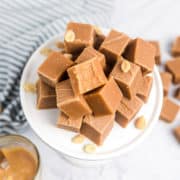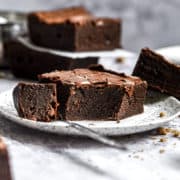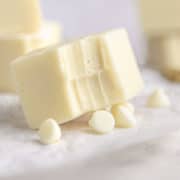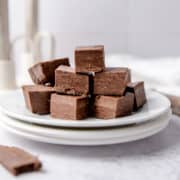Jalapenos feature in many recipes where the goal is to give the dish a little spice. These mild to medium peppers don't offer a huge kick of heat but they are tasty.

Jump to:
Jalapenos can be stuffed, minced, chopped, and often feature in Mexican cuisine, as well as Asian cuisines, and are wonderful added to pho if you like spicy soup recipes. Discover how to store jalapenos so you can grow or purchase as many as you want at once and keep them in tip-top shape.
You can find fresh jalapenos at most grocery stores, along with just about every South American market and also farmers' markets. You can get them loose or bagged. They also come pickled or preserved.
Try them in egg dishes like omelets, scrambled eggs, and egg puffs. I love to make jalapeno poppers. I halve the spicy peppers lengthways, fill them with a mixture of cream cheese, shredded cheddar, and onion powder, press the halves back together, wrap them in bacon, and grill until crispy!
They are such a wonderful snack and, since some peppers are mild while others seem medium or even hot, you never know what you're going to get until you bite into it.
What are Jalapenos?
Jalapenos (Capsicum Annuum) are a member of the nightshade (Solanaceae) family, along with tomatoes, potatoes, and eggplants. They are usually green but can fully ripen to become orange, red, or yellow. The red ones are usually a little sweeter than the green ones because they've been on the plant for longer.
As regards nutrition, one jalapeno offers as much as 10% of your recommended daily intake of Vitamin C, along with Vitamins A, B6, and K, fiber, manganese, and folate. Since the usual serving size is pretty small, especially if you're just adding a single pepper to a dish for a touch of spice, you will need to eat other healthy veggies too to get your full recommended daily intake.
The word "jalapeno" comes from Xalapa or Jalapa, the capital of Mexico's Veracruz. This is where they originated, but today this type of chili pepper is grown all over the world. A jalapeno plant isn't hard to grow if you have green fingers!
Typical chili pepper plants will grow up to 2 or even 3 feet high, and produce up to 40 peppers. Grab some the next time you're at the grocery store - they're among the cheapest of all fresh peppers.
If the grocery store is out of jalapenos, you can substitute serrano peppers which are similar but a little spicier, and Fresno peppers which are also similar to jalapenos but again a bit hotter. Fresno chilies have fruity, smoky undertones and are especially good in salsa recipes. If you want something that has less heat than a jalapeno but a similar flavor, opt for an Anaheim pepper instead. You could even use bell pepper in your recipe if you prefer no heat at all.
How to Choose the Best Jalapenos
When shopping for canned jalapenos you pretty much just have to check the best-by date, but what about fresh ones? How do you select the best? Fresh-looking peppers without spots, mold, or bruised patches are the kind to pick.
Jalapenos differ in size a bit but this doesn't affect the flavor, so just choose the best size for what you're making. I will get the biggest ones if I'm going to stuff them, or any size if I'm going to slice, chop or mince them.
If you prefer hot peppers, look for older whole jalapenos with looser skin and fine lines. If a tamer bite is what you're after, choose smooth-skinned peppers which are younger and should have a milder taste. Knowing this is one of the easiest ways to ensure you get exactly the heat level you want.

How to Store Jalapenos
It's a good idea to know how to store jalapenos so you can keep them in peak condition and add them to your favorite recipes. It's not hard to get the best jalapeno shelf life, as long as you know how and where to keep them. That way you'll have fresh, ripe jalapenos for all your jalapeno recipes.
- Keep whole peppers in a dry place at room temperature if you plan to use them within a day or two. A dry location is important, or else they won't last until the next day.
- Wrap them in plastic wrap or put them in a plastic bag and store them in the fridge's crisper drawer if you want them to last a week.
- Instead of the plastic wrap, you can keep them in the package they came in, use aluminum foil, or put them in a plastic or paper bag.
- Another option is to put your fresh jalapeños in an airtight container with a paper towel on the bottom and on top since moisture causes peppers to spoil faster and the paper towel can absorb the excess moisture.
The best way to keep them for a long time is to freeze them. They will be good for up to 12 months and maintain their flavor, although the texture will be less crisp when thawed. Either vacuum seal them or put them in a freezer Ziplock bag or freezer-safe container for the best quality outcome.
You can also slice them and freeze them on a baking sheet before transferring them into a freezer bag or freeze minced jalapenos in ice cube trays with or without a splash of olive oil. One jalapeno ice cube is the same as 2 tablespoons of fresh minced jalapeno and the best thing about this is there is no weighing or measuring required.
Finally, you can pickle or preserve your own and use a pressure canner to seal them up. These jars of pickled peppers should be fine for up to a year kept in a dry, cool place, and it's a great way to store your green jalapeños long-term if you happen to have a lot of them on hand.
How to Spot a Spoiled Jalapeno
These chili peppers wrinkle as they age. Slightly wrinkled ones can still be eaten but if you spot any mold, they're no good. You should also throw them out if there is a sour smell or if they're slimy or brown inside. With canned jalapeno slices, a brownish color or unpleasant smell means they're rotten.
Common Questions
Jalapenos are mild to medium-spice level peppers, similar to serranos but less hot. On the Scoville heat index, they range from 2500 to 8000 units, which is quite low compared to other hot peppers.
The spiciness is somewhere between poblanos and habaneros, but factors such as the pH level of the soil and how much sunlight the plants get affect how hot they are. The heat comes from capsaicin, which is a chemical compound in the white "ribs" of the pepper.
If you want your piquant peppers to last a very long time, the best option might be to dry them. This is a very easy process. Thread a needle and string the chilies by the stems.
Either leave them hanging or take them off the string once dried and keep them in airtight containers, such as pint jars with lids, at room temperature. Grind them into a powder to add spice to recipes. Dried peppers are a great addition to many different dishes. They will stay good indefinitely although the flavor will fade over time.
A second method to dry jalapenos is to use a dehydrator or else oven drying sliced peppers at the lowest temperature. Don't forget to wash your hands or wear gloves when working with jalapenos. The chemical that gives these peppers their spice can cause burns and once you've accidentally touched your eye after chopping chilies, you won't forget the experience in a hurry.

Interesting Facts
- Jalapenos and chiltepins are the state peppers of Texas.
- These peppers have been included on the Space Shuttle since the 1980s. They were the first peppers in space!
- The chemical compound that makes jalapenos hot is found in the pithy white ribs and not the seeds, which means that's the part to remove if you want to tame the bite of your chilies. You can remove the seeds too of course but, contrary to popular belief, that doesn't affect the spice factor.
Now you know how to store jalapenos, you can keep them fresh for longer and try all different kinds of tasty recipes, including poppers, curries, sauces salsas, and more sides.














